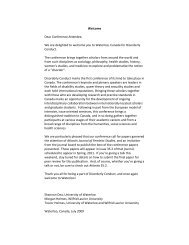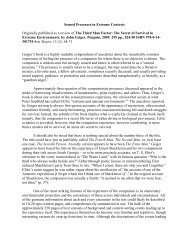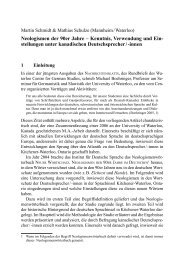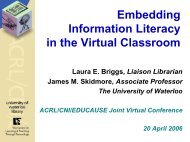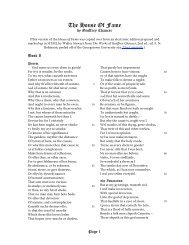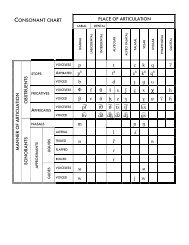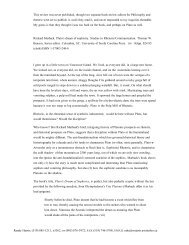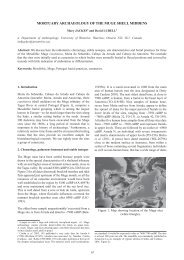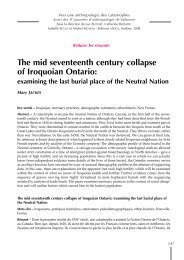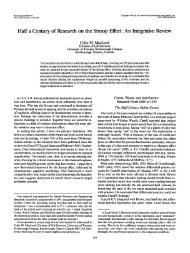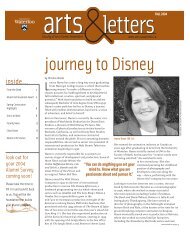Individual Differences in Learning and Memory: A Unitary ...
Individual Differences in Learning and Memory: A Unitary ...
Individual Differences in Learning and Memory: A Unitary ...
You also want an ePaper? Increase the reach of your titles
YUMPU automatically turns print PDFs into web optimized ePapers that Google loves.
JOURNAL OF RESEARCH IN PERSONALITY 13, 530-545 (1979)<br />
<strong>Individual</strong> <strong>Differences</strong> <strong>in</strong> Learn<strong>in</strong>g <strong>and</strong> <strong>Memory</strong>: A <strong>Unitary</strong><br />
Information Process<strong>in</strong>g Approach<br />
COLIN M. MACLEOD<br />
Scarborough College, University of Toronto<br />
Recent research <strong>in</strong> the area of <strong>in</strong>dividual differences <strong>in</strong> learn<strong>in</strong>g <strong>and</strong> memory is<br />
reviewed from a cognitive perspective. Us<strong>in</strong>g the two-state model of memory as a<br />
framework, <strong>in</strong>dividual variations <strong>in</strong> attentional, short-term store, <strong>and</strong> long-term<br />
store processes are discussed. The focus is on us<strong>in</strong>g <strong>in</strong>dividual differences to<br />
evaluate nomothetic cognitive models, as well as on us<strong>in</strong>g cognitive models <strong>in</strong><br />
guid<strong>in</strong>g research on <strong>in</strong>dividual differences. Both with<strong>in</strong>-<strong>in</strong>dividual <strong>and</strong> between-<br />
<strong>in</strong>dividual differences <strong>in</strong> basic processes are exam<strong>in</strong>ed. In so do<strong>in</strong>g, the impor-<br />
tance of strategy choice is stressed us<strong>in</strong>g the concept of cognitive flexibility.<br />
Several promis<strong>in</strong>g directions, both methodologicat <strong>and</strong> theoretical, are noted <strong>and</strong><br />
the value of us<strong>in</strong>g specific <strong>in</strong>formation process<strong>in</strong>g models <strong>in</strong> the study of <strong>in</strong>dividual<br />
differences is emphasized.<br />
The study of how people differ <strong>in</strong> their abilities to learn <strong>and</strong> remember<br />
has a decidedly uneven history. Short periods of enthusiastic activity<br />
<strong>in</strong>evitably seem to lead to long periods of what might best be called<br />
“hibernation.” Furthermore, recurrent attempts to re<strong>in</strong>troduce the study<br />
of <strong>in</strong>dividual differences (e.g., Gag&, 1967; Jenk<strong>in</strong>s & Lykken, 1957;<br />
Sargent, 1942) seem to be heralded only by those already committed,<br />
ga<strong>in</strong><strong>in</strong>g few converts. We still cannot make very many firm statements<br />
based on our knowledge of <strong>in</strong>dividual differences. Nevertheless, the last<br />
decade has seen considerable activity with<strong>in</strong> this “second tradition” of<br />
scientific psychology, <strong>and</strong> the growth appears to be cont<strong>in</strong>u<strong>in</strong>g (see, for<br />
example, the recent reviews by Carroll & Maxwell, 1979; Eysenck, 1977).<br />
It is particularly encourag<strong>in</strong>g to see an emphasis on the role of <strong>in</strong>dividual<br />
differences <strong>in</strong> the development of theory (e.g., Underwood, 1973, for any<br />
theory is necessarily a statement of optimism with respect to its doma<strong>in</strong>.<br />
This issue of the journal presents the work of a number of different<br />
<strong>in</strong>vestigators <strong>in</strong>volved <strong>in</strong> study<strong>in</strong>g personality differences <strong>and</strong> their role <strong>in</strong><br />
Portions of this article were previously presented <strong>in</strong> a symposium entitled “Personality<br />
<strong>and</strong> <strong>Memory</strong>” at the 86th annual convention of the American Psychological Association <strong>in</strong><br />
Toronto, September 1978. Requests for repr<strong>in</strong>ts may be sent to Col<strong>in</strong> M. MacLeod, Division<br />
of Life Sciences, Scarborough College, University of Toronto, West Hill, Ontario MlC lA4,<br />
CANADA.<br />
0092-6566/79/040530-16$02.00/O<br />
Copyright @ 1979 by Academic Press, Inc.<br />
All rights of reproduction <strong>in</strong> any form reserved.
DIFFERENCES IN LEARNING AND MEMORY 531<br />
learn<strong>in</strong>g <strong>and</strong> memory. My purpose is to review the work <strong>in</strong> another area of<br />
<strong>in</strong>dividual differences, the cognitive approach to learn<strong>in</strong>g <strong>and</strong> memory.<br />
By necessity, this review will be highly selective, focus<strong>in</strong>g on a s<strong>in</strong>gle<br />
model <strong>and</strong> largely exclud<strong>in</strong>g the factor analytic evidence (but for an<br />
excellent review, see Carroll & Maxwell, 1979). Still, the hope is that it<br />
will help to reveal some of the parallels between the personality <strong>and</strong><br />
cognitive approaches, some of the discrepancies, <strong>and</strong> some of the issues<br />
be<strong>in</strong>g ignored by both camps.<br />
This article beg<strong>in</strong>s with a short <strong>in</strong>troduction to the prototypical <strong>in</strong>forma-<br />
tion process<strong>in</strong>g model of memory, the two-state model. In part, this<br />
approach is adopted to complement the review by Eysenck (1977), which<br />
takes a levels-of-process<strong>in</strong>g orientation (Craik & Lockhart, 1972). How-<br />
ever, I believe that the two-state model offers a better organizational<br />
scheme <strong>and</strong> does not have the predictive problems recently po<strong>in</strong>ted out by<br />
Nelson (1977) <strong>and</strong> Baddeley (1978). To reflect this concern, I have tried to<br />
suggest how one might phrase <strong>in</strong>dividual differences questions <strong>in</strong> terms of<br />
the two-state model. Us<strong>in</strong>g the component structures <strong>and</strong> processes of the<br />
model as an organizational framework, the next section of the article<br />
reviews an illustrative subset of the recent research <strong>in</strong> <strong>in</strong>dividual differ-<br />
ences. In this, the largest section of the article, I have attempted as much<br />
as possible to <strong>in</strong>tegrate the rather disparate f<strong>in</strong>d<strong>in</strong>gs. The f<strong>in</strong>al section<br />
provides an overview <strong>and</strong> po<strong>in</strong>ts to some of the emerg<strong>in</strong>g issues.<br />
THE INFORMATION PROCESSING MODEL<br />
The hallmark of cognitive approaches to the nomothetic study of learn-<br />
<strong>in</strong>g <strong>and</strong> memory is their reliance on box models such as the one shown <strong>in</strong><br />
Fig. 1. In this simplified version of the two-store model (cf. Atk<strong>in</strong>son &<br />
Shiffr<strong>in</strong>, 1%8), <strong>in</strong>puts enter the system through modality-specific sensory<br />
registers. These are brief “clear<strong>in</strong>g houses,” upon which attentional<br />
processes operate to select situation-relevant <strong>in</strong>formation. The hub of the<br />
system is the short-term store (STS), which can be likened to “conscious-<br />
ness.” Once selected <strong>in</strong>formation <strong>in</strong> the sensory register has been pattern<br />
recognized, it enters STS, the work<strong>in</strong>g memory (Baddeley & Hitch, 1974).<br />
Here a wide array of control processes, or strategies, can be called up<br />
from long-term store (LTS) <strong>and</strong> implemented. Among these are rehearsal<br />
schemes, encod<strong>in</strong>g <strong>and</strong> decod<strong>in</strong>g rout<strong>in</strong>es, <strong>and</strong> retrieval plans, to <strong>in</strong>dicate<br />
just a few. The goal state is LTS, the permanent storehouse of <strong>in</strong>forma-<br />
tion.<br />
There are only two major departures <strong>in</strong> Fig. 1 from the Atk<strong>in</strong>son <strong>and</strong><br />
Shiffr<strong>in</strong> (1968) model. First, there is a further subdivision of LTS <strong>in</strong>to a<br />
semantic <strong>and</strong> an episodic component. This is consistent with Tulv<strong>in</strong>g’s<br />
(1972) dist<strong>in</strong>ction between event-related <strong>in</strong>formation (episodic), <strong>and</strong><br />
event-free knowledge (semantic). Second, the pivotal “rehearsal buffer”<br />
<strong>in</strong> STS used <strong>in</strong> the orig<strong>in</strong>al model has been de-emphasized <strong>and</strong> now is
532 COLIN M. MACLEOD<br />
A%P *-------------------------, ,<br />
Pattern<br />
,<br />
Recognition I<br />
SHORT-TERM<br />
RESPONSE<br />
GENERATION<br />
FIG. 1. The prototypical two-state model of memory.<br />
<strong>in</strong>cluded as one of the available control processes. This change reflects<br />
the recent focus on process<strong>in</strong>g (as opposed to structural) variables <strong>in</strong><br />
learn<strong>in</strong>g <strong>and</strong> memory (cf. Craik & Lockhart, 1972).<br />
With this type of model <strong>in</strong> m<strong>in</strong>d, one can beg<strong>in</strong> to frame questions about<br />
<strong>in</strong>dividual differences <strong>in</strong> specific memory functions. A partial list of such<br />
questions might <strong>in</strong>clude:<br />
(1) Do people differ <strong>in</strong> the capacity of their sensory registers?’<br />
(2) Is attentionai allocation ability a source of <strong>in</strong>dividual differences? Does the<br />
speed of pattern recognition vary between <strong>in</strong>dividuals?<br />
(3) Can some people use STS more efficiently than others? Do some <strong>in</strong>dividuals<br />
have a larger set of available control processes?<br />
(4) What sorts of control processes should be used to accomplish optimal transfer,<br />
<strong>and</strong> do these differ from person to person?<br />
(5) Are <strong>in</strong>dividual differences <strong>in</strong> LTS primarily <strong>in</strong> the episodic or the semantic<br />
component? Does the efficiency of retrieval (<strong>and</strong> perhaps the utility of various<br />
cues) represent a dist<strong>in</strong>ct ability?<br />
Clearly, these are all possibilities <strong>and</strong>, with a little imag<strong>in</strong>ation, one can<br />
generate numerous other c<strong>and</strong>idates. Instead, let us look at some of the<br />
research this sort of model has generated, restrict<strong>in</strong>g discussion to post-<br />
perceptual process<strong>in</strong>g.<br />
1 Although I am omitt<strong>in</strong>g any discussion of <strong>in</strong>dividual differences <strong>in</strong> preattentional pro-<br />
cess<strong>in</strong>g, there is some evidence that this is an area worth pursu<strong>in</strong>g. For <strong>in</strong>stance, Snow<br />
(Note 12) discusses several studies of mask<strong>in</strong>g phenomena <strong>in</strong> iconic memory which clearly<br />
demonstrate <strong>in</strong>ter-subject differences.
Attention<br />
DIFFERENCES IN LEARNING AND MEMORY 533<br />
SOURCES OF INDIVIDUAL DIFFERENCES<br />
To beg<strong>in</strong> exam<strong>in</strong><strong>in</strong>g <strong>in</strong>dividual differences <strong>in</strong> attention, some sort of<br />
model is required. Kahneman (1973) <strong>and</strong> Norman <strong>and</strong> Bobrow (1975) have<br />
proposed rather similar systems based on the core notion of a s<strong>in</strong>gle pool<br />
of attentional resources available for the <strong>in</strong>dividual to allocate. This class<br />
of models offers some rather straightforward possibilities for an <strong>in</strong>dividual<br />
differences analysis. For example, <strong>in</strong>dividuals might differ <strong>in</strong> how effec-<br />
tive they are at mobiliz<strong>in</strong>g these resources when attention must be<br />
switched from one <strong>in</strong>put to another. Gopher <strong>and</strong> Kahneman (1971) pre-<br />
sent evidence <strong>in</strong> support of this prediction-the ability to switch attention<br />
from one ear to the other is an orderly function of the proficiency of<br />
military pilots. The same sort of pattern emerged <strong>in</strong> a later study us<strong>in</strong>g bus<br />
drivers’ safety records as the criterion variable (Kahneman, Ben-Ishai, &<br />
Lotan, 1973). Interest<strong>in</strong>gly, driv<strong>in</strong>g ability is a rather poor predictor of<br />
errors <strong>in</strong>focused attention <strong>in</strong> these same studies. Apparently, safe drivers<br />
make fewer errors when switch<strong>in</strong>g attention, but are not superior other-<br />
wise! This suggests that a study of <strong>in</strong>dividual differences <strong>in</strong> decision<br />
mak<strong>in</strong>g might have been quite reveal<strong>in</strong>g.<br />
More recently, Lansman (Note 7) has approached the exam<strong>in</strong>ation of<br />
<strong>in</strong>dividual differences <strong>in</strong> attention <strong>and</strong> memory from a different perspec-<br />
tive. Her hypothesis was that attention might play a central role <strong>in</strong> a<br />
person’s ability to ma<strong>in</strong>ta<strong>in</strong> a memory load <strong>and</strong> perform another task<br />
simultaneously, a situation we f<strong>in</strong>d ourselves <strong>in</strong> all too often. She tested<br />
this hypothesis with a secondary task methodology, us<strong>in</strong>g verbal ability as<br />
the critical <strong>in</strong>dividual differences variable. Although a subject’s digit span<br />
predicted how many items could be held <strong>in</strong> STS without attention (i.e.,<br />
while perform<strong>in</strong>g a second, attention-dem<strong>and</strong><strong>in</strong>g task), overall verbal<br />
ability was not predictive. Furthermore, verbal ability failed to predict<br />
rehearsal efficiency <strong>in</strong> STS, as measured by how much spare attentional<br />
capacity a subject had available to respond to an extraneous probe while<br />
perform<strong>in</strong>g a memory task.<br />
If one views Lansman’s tasks as more <strong>in</strong> the “focused” attention<br />
tradition, then her results can be seen as consistent with those of Kahne-<br />
man et al. (1973) <strong>and</strong> Gopher <strong>and</strong> Kahneman (1971). However, respond<strong>in</strong>g<br />
to a probe apart from the memory task does appear to be an attention-<br />
switch<strong>in</strong>g situation. Perhaps the <strong>in</strong>consistency between the two sets of<br />
studies stems from the dissimilarity of the variables chosen to def<strong>in</strong>e the<br />
<strong>in</strong>ter-subject differences. Whatever the reason, it still appears that the<br />
role attention plays <strong>in</strong> the memory system can be studied from the per-<br />
spective of <strong>in</strong>dividual differences. In fact, given the problems <strong>in</strong> theoriz-<br />
<strong>in</strong>g about attention, <strong>in</strong>dividual differences studies may provide fertile
534 COLIN M. MACLEOD<br />
ground for test<strong>in</strong>g nomothetic theories. Underwood (1975) already has<br />
<strong>in</strong>dicated the importance of this enterprise to theory <strong>in</strong> general.<br />
Short-Term Store Capacity<br />
Perhaps the most pervasive feature of any <strong>in</strong>dividual differences ap-<br />
proach to memory, be it factor analytic (e.g., Kelley, 1964), cl<strong>in</strong>ical (e.g.,<br />
Erickson & Scott, 1977), or experimental (e.g., Underwood, Boruch, &<br />
Malmi, Note 13), is the emphasis on a memory span construct. In terms of<br />
the model, this is a direct attack on the capacity of STS. Span ditfer-<br />
entiates the extremes <strong>in</strong> STS capacity well, as studies of retardates (e.g.,<br />
Chi, 1976) <strong>and</strong> mnemonists (e.g., Hunt & Love, 1972) clearly demon-<br />
strate. Although span may be less useful <strong>in</strong> discrim<strong>in</strong>at<strong>in</strong>g capacity differ-<br />
ences with<strong>in</strong> the normal range of abilities (cf. Hunt, 1978; Matarazzo,<br />
1972), it has had some success here as well. Furthermore, look<strong>in</strong>g at<br />
several studies together, an <strong>in</strong>terest<strong>in</strong>g pattern has emerged over the last<br />
couple of years.<br />
A popular hypothesis to account for <strong>in</strong>dividual differences <strong>in</strong> span relies<br />
on the notion that mnemonic strategies play a central role (e.g., Belmont<br />
& Butterfield, 1971; Ellis, 1970). Thus, rehearsal <strong>and</strong> chunk<strong>in</strong>g strategies<br />
should be crucial, as should temporal characteristics of the <strong>in</strong>put. Appeal-<br />
<strong>in</strong>g as this argument may be, it is almost certa<strong>in</strong>ly wrong. Studies of adults<br />
(Lyon, 1977) <strong>and</strong> children (Huttenlocher & Burke, 1976) have been fairly<br />
conclusive on this po<strong>in</strong>t. Why these differences exist is still an open<br />
question, but these studies show that the <strong>in</strong>dividual differences route<br />
could help clarify general theoretical concerns with the capacity of STS.<br />
In the context of the present model, this is a crucial direction to pursue.<br />
Short-Term Store Search<br />
The two-state model of memory h<strong>in</strong>ges on the STS construct. For this<br />
reason, much of the research effort has been directed at def<strong>in</strong><strong>in</strong>g the<br />
characteristics of STS. One of the most studied characteristics is the<br />
scann<strong>in</strong>g of STS for target <strong>in</strong>formation, based on the paradigm <strong>in</strong>troduced<br />
by Sternberg (1966, 1975). The picture that emerges from memory scan<br />
with respect to <strong>in</strong>dividual differences is very rem<strong>in</strong>iscent of the picture<br />
observed with memory span-at the extremes, scann<strong>in</strong>g times seem to be<br />
affected, but the pattern disappears <strong>in</strong> the normal range (cf. Hunt, 1978).<br />
Harris <strong>and</strong> Fleer (1974) observed markedly slowed scann<strong>in</strong>g <strong>in</strong> retard-<br />
ates <strong>and</strong> Hunt <strong>and</strong> Love (1972) observed very rapid scann<strong>in</strong>g <strong>in</strong> their<br />
mnemonist subject. However, for college students vary<strong>in</strong>g <strong>in</strong> verbal abil-<br />
ity, the results are far from straightforward. Hunt, Frost, <strong>and</strong> Lunneborg<br />
(1973) obta<strong>in</strong>ed slightly more rapid scann<strong>in</strong>g <strong>in</strong> high verbal students, but<br />
this difference apparently is not reliable (Hunt, 1978). Furthermore,<br />
Chiang <strong>and</strong> Atk<strong>in</strong>son (1976) found the opposite result to Hunt et al. (1973),
DIFFERENCES IN LEARNING AND MEMORY 535<br />
<strong>in</strong> that their male subjects showed slower scann<strong>in</strong>g with greater verbal<br />
ability. To add to the confusion, verbal ability <strong>and</strong> scann<strong>in</strong>g rate were<br />
unrelated <strong>in</strong> their female subjects! What are we to make of this?<br />
For the present, the evidence seems to suggest little relationship be-<br />
tween STS scann<strong>in</strong>g <strong>and</strong> ability measures <strong>in</strong> the normal range. Perhaps, as<br />
Hunt (1978) suggests, a more dem<strong>and</strong><strong>in</strong>g search task would reveal a more<br />
reliable pattern. One might consider, for example, a version of the “trans-<br />
lation” scann<strong>in</strong>g paradigm developed by Cruse <strong>and</strong> Clifton (1973). Still, it<br />
may be that search<strong>in</strong>g STS is simply not a locus of <strong>in</strong>dividual differences<br />
<strong>in</strong> memory. If so (<strong>and</strong> we must await clarification), this will be an impor-<br />
tant f<strong>in</strong>d<strong>in</strong>g. In any study of <strong>in</strong>dividual differences, it is important not<br />
simply to f<strong>in</strong>d differences, but to f<strong>in</strong>d an orderly pattern of differences.<br />
F<strong>in</strong>d<strong>in</strong>g no difference on some task assures us that our observed differ-<br />
ences are not due to some unknown general factor that will produce a<br />
difference <strong>in</strong> any task. By the same logic, f<strong>in</strong>d<strong>in</strong>g some process that is<br />
<strong>in</strong>dependent of a particular ability permits us to elim<strong>in</strong>ate from considera-<br />
tion some theoretical accounts. Certa<strong>in</strong>ly, this is a fundamental goal of<br />
study<strong>in</strong>g <strong>in</strong>dividual differences.<br />
Control Processes <strong>in</strong> Short-Term Store<br />
In the orig<strong>in</strong>al Atk<strong>in</strong>son <strong>and</strong> Shiffr<strong>in</strong> (1968) model, the nature of control<br />
processes (apart from rote rehearsal) was left unspecified. S<strong>in</strong>ce the levels<br />
of process<strong>in</strong>g framework was proposed (Craik & Lockhart, 1972), control<br />
processes have been emphasized <strong>in</strong> memory research, generally with<strong>in</strong><br />
the <strong>in</strong>cidental learn<strong>in</strong>g paradigm. However, there has been little empirical<br />
<strong>in</strong>terest <strong>in</strong> how <strong>in</strong>dividuals differ <strong>in</strong> these processes, despite some sugges-<br />
tive historical precedents (e.g., Plenderleith & Postman, 1957). Perhaps<br />
because of the qualitative effects sought <strong>in</strong> most of the current research<br />
(<strong>and</strong> the measurement problems <strong>in</strong>volved <strong>in</strong> compar<strong>in</strong>g performance<br />
across different <strong>in</strong>cidental tasks), the additional problems <strong>in</strong>volved <strong>in</strong><br />
exam<strong>in</strong><strong>in</strong>g <strong>in</strong>dividual differences have seemed too great. Yet <strong>in</strong>dividual<br />
differences relationships need not be quantitative, as theoretical notions<br />
rely<strong>in</strong>g on “moderator variables” (cf. Wigg<strong>in</strong>s, 1973) certa<strong>in</strong>ly demon-<br />
strate.<br />
Given the large number of potential control processes, where should<br />
one beg<strong>in</strong> search<strong>in</strong>g for <strong>in</strong>dividual differences? Possibly, the ability to<br />
choose an optimal control process <strong>and</strong> to implement it effectively could be<br />
a source of differences. If so, we should look for this superord<strong>in</strong>ate ability<br />
before focus<strong>in</strong>g on <strong>in</strong>dividual subprocesses. Consider for example a con-<br />
cept that might be calledflexibility of <strong>in</strong>formation process<strong>in</strong>g. Exactly this<br />
sort of idea has appeared <strong>in</strong> two recent reports, one from the attentional<br />
doma<strong>in</strong> <strong>and</strong> one from the verbal learn<strong>in</strong>g tradition.2<br />
* It is worth po<strong>in</strong>t<strong>in</strong>g out that similar concepts have been put forth <strong>in</strong> the doma<strong>in</strong> of<br />
personality differences related to memory. Both Mueller (1979), <strong>in</strong> discuss<strong>in</strong>g anxiety, <strong>and</strong>
536 COLIN M. MACLEOD<br />
Keele, Neil& <strong>and</strong> de Lemos (Note 6) have begun to develop a theory of<br />
what they call “attentional flexibility,” which relies on the importance of<br />
attention switch<strong>in</strong>g, as discussed earlier. As they expla<strong>in</strong> the logic of their<br />
research, “If a trait exists, then people that can rapidly switch set on one<br />
task should also be able to rapidly switch set <strong>in</strong> a different k<strong>in</strong>d of<br />
sett<strong>in</strong>g.” They have <strong>in</strong>vestigated the relationships among a set of tasks<br />
<strong>in</strong>clud<strong>in</strong>g h<strong>and</strong>l<strong>in</strong>g unexpected signals <strong>and</strong> switch<strong>in</strong>g from one dichotic<br />
message to another. The results are encourag<strong>in</strong>g for the concept of atten-<br />
tional flexibility <strong>in</strong> that performance across their tasks is systematically<br />
related, although the question of how to predict which <strong>in</strong>dividuals possess<br />
this trait rema<strong>in</strong>s to be tackled.<br />
Battig (1979) has <strong>in</strong>troduced a concept he calls “cognitive flexibility”<br />
which he uses to focus attention on <strong>in</strong>traperson differences <strong>in</strong> verbal<br />
learn<strong>in</strong>g <strong>and</strong> problem solv<strong>in</strong>g. While most of the work I have discussed<br />
<strong>in</strong>volves differences between people, Battig rightly recognizes the crucial<br />
nature of differences with<strong>in</strong> an <strong>in</strong>dividual under vary<strong>in</strong>g circumstances.3<br />
Battig def<strong>in</strong>es cognitive flexibility <strong>in</strong> terms of two ma<strong>in</strong> assumptions: (a)<br />
“the availability <strong>in</strong> the <strong>in</strong>dividual’s repertoire of a large number <strong>and</strong> wide<br />
range of alternative types of strategies <strong>and</strong> processes” <strong>and</strong> (b) “the ability<br />
to select one or more alternatives that are appropriate <strong>and</strong> effective for the<br />
required task.” Not<strong>in</strong>g the similarity of this concept to factors found <strong>in</strong><br />
models of personality <strong>and</strong> <strong>in</strong>telligence, it is nonetheless a useful way of<br />
conceptualiz<strong>in</strong>g a higher-order control process.<br />
In his own earlier research, Battig had demonstrated the importance of<br />
verbal ability <strong>in</strong> a word-guess<strong>in</strong>g task (Battig, 1957) <strong>and</strong> had shown that<br />
<strong>in</strong>structed subjects provided with the appropriate <strong>in</strong>formation could alter<br />
their performance accord<strong>in</strong>gly (Battig, 1958). In a more recent pair of<br />
studies <strong>in</strong> another doma<strong>in</strong>, a similar observation has been made. Mac-<br />
Leod, Hunt, <strong>and</strong> Mathews (1978) showed that a group of subjects solved<br />
simple sentence-picture problems <strong>in</strong> two different ways, depend<strong>in</strong>g on the<br />
<strong>in</strong>dividual’s spatial ability. However, given the appropriate <strong>in</strong>structions<br />
<strong>and</strong> tra<strong>in</strong><strong>in</strong>g, subjects can be led to adopt either of the two strategies<br />
successfully (Mathews, Hunt, & MacLeod, Note 9). This sort of ap-<br />
proach, observ<strong>in</strong>g an <strong>in</strong>tersubject difference <strong>and</strong> then essentially provid-<br />
<strong>in</strong>g an explicit control process to exam<strong>in</strong>e <strong>in</strong>trasubject differences, may<br />
prove to be a valuable method for pursu<strong>in</strong>g Battig’s idea of cognitive<br />
flexibility.<br />
Davis <strong>and</strong> Frank (1979), <strong>in</strong> discuss<strong>in</strong>g field dependence, have <strong>in</strong>voked a flexibility notion.<br />
Although there is some temptation <strong>in</strong> both the personality <strong>and</strong> cognitive enterprises to<br />
rediscover “general <strong>in</strong>telligence,” I believe that this can be avoided <strong>and</strong> that flexibility is a<br />
useful concept.<br />
3 Of course, we are aware of these differences at an <strong>in</strong>trospective level, but studies such<br />
as Folkard’s (1975) exam<strong>in</strong>ation of diurnal variation <strong>in</strong> arousal <strong>and</strong> cognitive skills po<strong>in</strong>t to<br />
the importance of this with<strong>in</strong>-person dimension.
DIFFERENCES IN LEARNING AND MEMORY 537<br />
I have already po<strong>in</strong>ted out the similar attack used by Lyon (1977) <strong>and</strong><br />
by Huttenlocher <strong>and</strong> Burke (1976) to study the role of rehearsal <strong>and</strong><br />
group<strong>in</strong>g processes <strong>in</strong> memory span differences. Another pair of recent<br />
studies extends our knowledge concern<strong>in</strong>g the role of rehearsal <strong>in</strong> mem-<br />
ory. Fagan (1972) showed that high-IQ subjects rehearsed earlier list items<br />
more than did lower-IQ subjects, result<strong>in</strong>g <strong>in</strong> the high-IQ subjects show-<br />
<strong>in</strong>g higher recall for these items. However, high-IQ subjects recalled<br />
fewer items from the recency portion of the list. Cohen <strong>and</strong> S<strong>and</strong>berg<br />
(1977) found what appears <strong>in</strong>itially to be a conflict<strong>in</strong>g result. In their<br />
study, the correlation between IQ <strong>and</strong> recall was restricted primarily to<br />
the recency portion of the list. How are these f<strong>in</strong>d<strong>in</strong>gs to be reconciled?<br />
Cohen <strong>and</strong> S<strong>and</strong>berg argue that subjects relied on LTS <strong>in</strong> Fagan’s<br />
free-recall task, while subjects <strong>in</strong> their modified serial-recall task relied on<br />
STS, suggest<strong>in</strong>g that two separate factors are <strong>in</strong>volved. They po<strong>in</strong>t out, <strong>in</strong><br />
addition, that their task was unique because order <strong>in</strong>formation was criti-<br />
cal. This leads to a rather tantaliz<strong>in</strong>g observation-the importance of<br />
order <strong>in</strong>formation seems quite pervasive <strong>in</strong> a broad array of <strong>in</strong>dividual<br />
differences studies. Consider the familiar Brown-Peterson short-term<br />
memory paradigm, where subjects have to hold a small set of stimuli <strong>in</strong><br />
STS dur<strong>in</strong>g a variable-length period of distraction. Hunt, Lunneborg, <strong>and</strong><br />
Lewis (1975) found that subjects high <strong>and</strong> low <strong>in</strong> verbal ability differed <strong>in</strong><br />
their number of errors <strong>in</strong> recall, <strong>and</strong> that a major dist<strong>in</strong>ction was <strong>in</strong><br />
retention of order <strong>in</strong>formation. The subjects with high verbal ability were<br />
more successful <strong>in</strong> reta<strong>in</strong><strong>in</strong>g the item order. Hunt et al. (1973) report a<br />
study by Nix that converges nicely on this result. Us<strong>in</strong>g a variant of the<br />
Brown-Peterson task, Nix demonstrated that subjects low <strong>in</strong> verbal ability<br />
showed equivalent release from proactive <strong>in</strong>terference (Wickens, 1970) to<br />
that evidenced by subjects high <strong>in</strong> verbal ability when order of item recall<br />
was not considered. However, scor<strong>in</strong>g for order, she found that the<br />
high-ability subjects performed better. Furthermore, this differential sen-<br />
sitivity to order <strong>in</strong> high-ability subjects reappeared <strong>in</strong> a difficult temporal<br />
order judgment task conducted by Poltrock <strong>and</strong> reported by Hunt et al.<br />
(1975).<br />
Mart<strong>in</strong> (1978) has provided confirmation of the results of Hunt <strong>and</strong> his<br />
associates. In her first experiment, she found that memory span, while<br />
unrelated to free-recall performance on either short-term memory or<br />
long-term memory tasks, was positively correlated with ordered recall.<br />
This pattern was consistent <strong>in</strong> a second experiment which aga<strong>in</strong> showed<br />
order <strong>in</strong>formation, but not item <strong>in</strong>formation, to be related to span.<br />
In these studies, order <strong>in</strong>formation was useful (or even required) <strong>in</strong><br />
perform<strong>in</strong>g the task. What about <strong>in</strong>stances where rely<strong>in</strong>g on order can be<br />
detrimental? Schwartz (1975) reports that high-anxiety subjects rely on<br />
order more than do low-anxiety subjects <strong>in</strong> recall, result<strong>in</strong>g <strong>in</strong> poorer<br />
overall performance for the high-anxiety subjects. AdditionalIy, Day
538 COLIN M. MACLEOD<br />
(Note 3) reports that her <strong>in</strong>flexible, language-bound subjects rely on order<br />
<strong>in</strong>formation that impedes the more semantic organization adopted by the<br />
flexible, language-optional subjects. Of course, the semantic strategy is<br />
more effective <strong>in</strong> solv<strong>in</strong>g the problem. Perhaps the availability of a control<br />
process to employ order <strong>in</strong>formation can be seen as one manifestation of<br />
the subject’s cognitive flexibility. Apparently, order sensitivity underlies<br />
a variety of <strong>in</strong>dividual differences, both <strong>in</strong> terms of personality <strong>and</strong> cogni-<br />
tion. This would be a worthwhile topic to follow up more systematically.<br />
While it would be a simple matter to outl<strong>in</strong>e isolated <strong>in</strong>dividual differ-<br />
ences <strong>in</strong> other control processes, I believe this might serve more to<br />
obscure than to clarify the issues. Research <strong>in</strong> this area is <strong>in</strong> need of a<br />
more unified approach if questions about optimal transfer strategies <strong>and</strong><br />
the <strong>in</strong>terrelationships of various (classes of) control processes are to be<br />
answered. What I have tried to illustrate is one possible framework,<br />
cognitive flexibility, <strong>and</strong> two areas to which it might be applied.<br />
Episodic Long-Term Store<br />
An obvious tactic for beg<strong>in</strong>n<strong>in</strong>g to disentangle the many attributes of<br />
LTS is the factor analysis of a wide array of long-term memory tasks. If<br />
certa<strong>in</strong> component processes are critical to several tasks, correspond<strong>in</strong>g<br />
factors should emerge. For example, factors correspond<strong>in</strong>g to temporal<br />
order or organizational cluster<strong>in</strong>g would be <strong>in</strong>tuitive c<strong>and</strong>idates. In an<br />
attempt to do this, Underwood, Boruch, <strong>and</strong> Malmi (Note 13) conducted a<br />
factor analysis on 22 variables from st<strong>and</strong>ard long-term memory tasks<br />
such as free recall, paired-associate learn<strong>in</strong>g, <strong>and</strong> verbal discrim<strong>in</strong>ation.<br />
Unfortunately, what appeared were five factors that seem to be highly<br />
task-bound (e.g., paired-associate learn<strong>in</strong>g <strong>and</strong> verbal discrim<strong>in</strong>ation).<br />
Although Carroll (1978) po<strong>in</strong>ts out that there seems to be a second-order<br />
factor correspond<strong>in</strong>g to associative memory, these results are still quite<br />
discourag<strong>in</strong>g. [Interest<strong>in</strong>gly, though, Underwood et al. suggest that sub-<br />
jects may possess sufficient flexibility to overshadow task-appropriate<br />
memory attributes.] Furthermore, Masson (Note 8) has factor-analyzed<br />
30 st<strong>and</strong>ard memory tasks <strong>and</strong> arrived at a similar impasse. For the<br />
present, at least, a different approach will be required.<br />
Consider a second approach proposed by Yen (1978) that is more <strong>in</strong> the<br />
spirit of the basic two-state model. Yen fitted a particular <strong>in</strong>formation<br />
process<strong>in</strong>g model (Rumelhart, Note 10) to the <strong>in</strong>dividual learn<strong>in</strong>g curves<br />
of grade-school students. She exam<strong>in</strong>ed two types of learn<strong>in</strong>g material,<br />
paired associates <strong>and</strong> word def<strong>in</strong>itions, f<strong>in</strong>d<strong>in</strong>g reliable <strong>in</strong>dividual ditfer-<br />
ences <strong>in</strong> two parameters of the model, acquisition rate, <strong>and</strong> long-term<br />
retention.4 The correlations between each of these parameters <strong>and</strong> her<br />
4 Hunt et al. (1973) report an analysis of the relationship between trials to acquisition <strong>and</strong><br />
long-term retention <strong>in</strong> paired-associate learn<strong>in</strong>g. Over three types of lists, they observed the
DIFFERENCES IN LEARNING AND MEMORY 539<br />
preferred measure of ability were sizable, despite the restricted range of<br />
her subjects on the ability test. Yen’s study illustrates a successful<br />
model-specific approach to study<strong>in</strong>g differences <strong>in</strong> LTS characteristics.<br />
Furthermore, it is an elegant demonstration of the value of a well-<br />
specified model <strong>in</strong> <strong>in</strong>vestigat<strong>in</strong>g <strong>in</strong>dividual differences <strong>in</strong> learn<strong>in</strong>g <strong>and</strong><br />
memory.<br />
Another model-dependent approach was alluded to earlier, that used by<br />
MacLeod et al. (1978) to exam<strong>in</strong>e strategy choice <strong>in</strong> perform<strong>in</strong>g a<br />
sentence-picture verification task (e.g., to verify that PLUS ABOVE<br />
STAR is false with respect to T, cf. Carpenter & Just, 1975). Depend<strong>in</strong>g<br />
on a subject’s spatial ability, two qualitatively different models applied.<br />
For 27% of the subjects (16 of 59), the task seemed to be performed as if<br />
compar<strong>in</strong>g holistic images; these were the subjects high <strong>in</strong> spatial ability.<br />
The rema<strong>in</strong><strong>in</strong>g 43 lower-spatial subjects used a more analytic comparison<br />
process described as l<strong>in</strong>guistic <strong>in</strong> nature. Cooper (Note 2) has found a<br />
strik<strong>in</strong>gly similar pattern <strong>in</strong> her studies <strong>in</strong>volv<strong>in</strong>g comparison of figural<br />
shapes. The subjects whose strategy she calls Type I “could be compar-<br />
<strong>in</strong>g a visual memory representation with a test shape <strong>in</strong> a holistic, parallel<br />
fashion,” while the subjects us<strong>in</strong>g the Type II strategy “could be us<strong>in</strong>g a<br />
more analytic comparison process.” Cooper (1976) reports that 2% (7 of<br />
24) of her subjects studied thus far have used the Type I strategy. Unfor-<br />
tunately, because of her relatively small sample, Cooper has been unable<br />
to conduct a correlational study <strong>in</strong>volv<strong>in</strong>g spatial ability similar to the<br />
MacLeod et al. analysis.<br />
That this is not a co<strong>in</strong>cidence seems virtually certa<strong>in</strong>. Day’s (Note 3)<br />
work with her language-bound <strong>and</strong> language-optional subjects dovetails<br />
neatly with the above results. For example, <strong>in</strong> nam<strong>in</strong>g U.S. states,<br />
language-optional subjects “may rely more heavily on a mental map,”<br />
while language-bound subjects may “rely more heavily on language-<br />
oriented means.” Although we do not know the relative frequencies of<br />
Day’s two groups <strong>in</strong> the population, she po<strong>in</strong>ts out that “there appear to<br />
be more language-bound subjects than language-optional subjects <strong>in</strong> the<br />
general population.”<br />
Such convergence across several disparate types of research is excit<strong>in</strong>g<br />
<strong>and</strong> encourag<strong>in</strong>g for the study of <strong>in</strong>dividual differences. Simultaneously,<br />
we can discover reliable process<strong>in</strong>g differences <strong>and</strong> evaluate nomothetic<br />
follow<strong>in</strong>g correlations: - 66 for number-verb pairs, -. 15 for number-noun pairs, <strong>and</strong> - .03<br />
for number-adjective pairs. They conclude that their results “certa<strong>in</strong>ly do not lend strong<br />
support to the proposition that there is a unitary memoriz<strong>in</strong>g ability.” However, they did not<br />
relate their results to extra-experimental ability measures, so we have no idea of the range of<br />
abilities represented. Furthermore, high negative correlations between acquisition <strong>and</strong> re-<br />
tention have been observed elsewhere (e.g., -64 for number-noun pairs by MacLeod,<br />
1976). Although item effects may be <strong>in</strong>volved, it is clear that this issue requires further<br />
<strong>in</strong>vestigation, particularly <strong>in</strong> light of Yen’s f<strong>in</strong>d<strong>in</strong>gs.
540 COLIN M. MACLEOD<br />
models, exactly the sort of goal Underwood (1975) has advocated. In<br />
addition, as Mathews et al. (Note 9) have shown, we can then attempt to<br />
teach these strategies as a means of evaluat<strong>in</strong>g flexibility. This “double-<br />
barreled” procedure offers a systematic, model-governed methodology<br />
for the study of processes operat<strong>in</strong>g <strong>in</strong> STS that are critical <strong>in</strong> promot<strong>in</strong>g<br />
<strong>in</strong>formation to LTS <strong>and</strong> perhaps even <strong>in</strong> determ<strong>in</strong><strong>in</strong>g the form of the LTS<br />
representation. It may be, too, that this approach will provide a l<strong>in</strong>k to<br />
<strong>in</strong>dividual differences research <strong>in</strong> other related areas, such as that of<br />
mental imagery (for reviews, see Ernest, 1977; Marks, 1977).<br />
Semantic Long-Term Store<br />
One of the tasks most frequently used <strong>in</strong> <strong>in</strong>formation process<strong>in</strong>g<br />
analyses of <strong>in</strong>dividual differences has been the match<strong>in</strong>g task developed<br />
by Posner <strong>and</strong> his colleagues (Posner & Mitchell, 1967; Posner, Boies,<br />
Eichelman, & Taylor, 1969). In the prototypical version of the task, two<br />
letters appear <strong>and</strong> the subject is required to <strong>in</strong>dicate whether the letters<br />
have the same name. Thus, the response is “same” to “AA” <strong>and</strong> “Aa,”<br />
but “different” to “AB” or “Ab.” Of particular <strong>in</strong>terest is the f<strong>in</strong>d<strong>in</strong>g that<br />
physical identity trials (“AA”) take less time than do name identity trials<br />
(“Aa”). This difference is taken as a measure of time to access the name<br />
code <strong>in</strong> semantic LTS, s<strong>in</strong>ce presumably only name identity trials require<br />
access to LTS. The work of Hunt <strong>and</strong> his colleagues (Hunt et al., 1973,<br />
1975) has repeatedly demonstrated a reliable relationship between the<br />
access measure <strong>and</strong> verbal ability. The pattern of results suggests that<br />
high verbal-ability subjects can access codes <strong>in</strong> LTS more rapidly than<br />
low verbal-ability subjects. Furthermore, <strong>in</strong> extensions to other groups of<br />
subjects (e.g., retardates), a quite orderly pattern of results has been<br />
obta<strong>in</strong>ed.<br />
More recent work <strong>in</strong> other laboratories has replicated <strong>and</strong> extended<br />
these f<strong>in</strong>d<strong>in</strong>gs. I will mention only two of these studies, s<strong>in</strong>ce Hunt (1978)<br />
reviews the evidence <strong>in</strong> detail. The first strongly supports Hunt’s results.<br />
Goldberg, Schwartz, <strong>and</strong> Stewart (1977) varied the abstractness of the<br />
relationship between the stimulus pairs by us<strong>in</strong>g physically identical<br />
words (DEER-DEER), homonyms (DEER-DEAR), <strong>and</strong> cohyponyms<br />
(DEER-ELK). They observed that as abstractness <strong>in</strong>creased so did the<br />
difference between subjects high <strong>and</strong> low <strong>in</strong> verbal ability.<br />
A second study us<strong>in</strong>g a different procedure purports to disconfirm<br />
predictions derived from the f<strong>in</strong>d<strong>in</strong>gs of Hunt <strong>and</strong> Goldberg et<br />
al. Hogoboam <strong>and</strong> Pellegr<strong>in</strong>o (1978) presented their subjects with a cate-<br />
gory name followed by a set of s<strong>in</strong>gle words <strong>and</strong> s<strong>in</strong>gle pictures to which<br />
the subjects responded “yes” or “no” as a function of whether the items<br />
were category members. Neither picture nor word verification reaction<br />
times showed a reliable relationship with verbal ability. However, their<br />
task was not a match<strong>in</strong>g task, <strong>and</strong> they were not deal<strong>in</strong>g with difference
DIFFERENCES IN LEARNING AND MEMORY 541<br />
scores. Furthermore, their claims aside, noth<strong>in</strong>g <strong>in</strong> the previous work<br />
leads directly to any predictions concern<strong>in</strong>g picture process<strong>in</strong>g. Thus, the<br />
lack of a relationship between verbal ability <strong>and</strong> picture categoriz<strong>in</strong>g time<br />
st<strong>and</strong>s apart from the earlier f<strong>in</strong>d<strong>in</strong>gs. The lack of a relationship for words<br />
is more puzzl<strong>in</strong>g, but may stem partially from the fact that subjects were<br />
provided with the category name <strong>in</strong> the Hogoboam <strong>and</strong> Pellegr<strong>in</strong>o study<br />
whereas they had to access it from LTS <strong>in</strong> the Goldberg at al. study.<br />
Rather than constitut<strong>in</strong>g a refutation of the conclusion regard<strong>in</strong>g code<br />
access based on the match<strong>in</strong>g studies, the Hogoboam <strong>and</strong> Pellegr<strong>in</strong>o<br />
results provide a theoretical <strong>and</strong> methodological challenge to them. It will<br />
be <strong>in</strong>terest<strong>in</strong>g to see how this is resolved.<br />
Code access is only one aspect of semantic LTS that could be exam-<br />
<strong>in</strong>ed. The structure of semantic space is also a potential source of <strong>in</strong>di-<br />
vidual differences, but there has been little research <strong>in</strong> this area. Apart<br />
from a demonstration by Loftus <strong>and</strong> Loftus (1974) that advanced graduate<br />
students <strong>in</strong> psychology show a superior organization of psychologists <strong>in</strong><br />
various areas to that evidenced by first-year students, I know of none. As<br />
always, separat<strong>in</strong>g structure from process is a complex problem, but this<br />
appears to be one area where the results could be very <strong>in</strong>formative.<br />
Analyses of the type conducted by Smith, Shoben, <strong>and</strong> Rips (1974) should<br />
be considered as a means of <strong>in</strong>vestigat<strong>in</strong>g <strong>in</strong>dividual differences <strong>in</strong> seman-<br />
tic LTS.<br />
CONCLUDING COMMENTS<br />
This brief review has only scratched the surface of the <strong>in</strong>formation<br />
process<strong>in</strong>g approach to <strong>in</strong>dividual differences. For example, I have not<br />
covered the many studies related to developmental trends <strong>in</strong> <strong>in</strong>dividual<br />
differences (e.g., Bisanz, Danner, & Resnick, Note 1; Keat<strong>in</strong>g & Bobbitt,<br />
1978), nor those related to ag<strong>in</strong>g (some of which are reviewed by Eysenck,<br />
1977). Neither have I discussed the work on more complex cognitive tasks<br />
such as read<strong>in</strong>g (e.g., Jackson & McClell<strong>and</strong>, 1979) <strong>and</strong> comprehen-<br />
sion (e.g., Perfetti & Lesgold, 1978). Instead, I have restricted my atten-<br />
tion solely to basic processes with<strong>in</strong> the framework of the two-state<br />
model.<br />
The field is <strong>in</strong> a period of rapid growth which I believe will cont<strong>in</strong>ue <strong>and</strong><br />
escalate. Hopefully, one of the directions taken will be to systematize<br />
some of the discrepant f<strong>in</strong>d<strong>in</strong>gs reported here. Hopefully, too, the organi-<br />
zation provided by <strong>in</strong>formation process<strong>in</strong>g models will be a guid<strong>in</strong>g force<br />
<strong>in</strong> this growth. It seems quite possible that one of the reasons for the<br />
uneven history of the field has been the lack of structure, the tendency to<br />
study <strong>in</strong>dividual differences <strong>in</strong> a haphazard fashion without benefit of<br />
theory. More consideration will have to be given to the higher-order<br />
theoretical issues (cf. Carroll, 1978; Hunt & MacLeod, 1978) as well as to<br />
the more specific ones.
542 COLIN M. MACLEOD<br />
In terms of the two-state model, many questions rema<strong>in</strong> unanswered.<br />
Certa<strong>in</strong>ly, the control processes utilized <strong>in</strong> STS must be <strong>in</strong>vestigated more<br />
fully with<strong>in</strong> the context of specific models, as <strong>in</strong> the case of scann<strong>in</strong>g.<br />
Transfer <strong>and</strong> retrieval, the processes connect<strong>in</strong>g STS <strong>and</strong> LTS, are obvi-<br />
ous sites for <strong>in</strong>dividual differences analyses, as is the organization of<br />
semantic memory. Yen’s work serves well as an example here. New<br />
theories such as the controlled-automatic dist<strong>in</strong>ction (Schneider & Shif-<br />
fr<strong>in</strong>, 1977) may be put to the <strong>in</strong>dividual differences test (e.g., Hunt,<br />
McKee, & Yantis, Note 5). More specific theories of encod<strong>in</strong>g <strong>and</strong> re-<br />
trieval <strong>in</strong> STS (Gorfe<strong>in</strong>, Note 4), of retrieval from LTS (Shiffr<strong>in</strong>, Note 1 l),<br />
<strong>and</strong> others will also make predictions that are testable by exam<strong>in</strong><strong>in</strong>g<br />
with<strong>in</strong>-<strong>in</strong>dividual <strong>and</strong> between-<strong>in</strong>dividual differences. As Melton con-<br />
cluded <strong>in</strong> his general comments at the Conference on Learn<strong>in</strong>g <strong>and</strong> Indi-<br />
vidual <strong>Differences</strong> <strong>in</strong> 1967:<br />
We cannot possibly have a good theory of the processes <strong>in</strong>volved <strong>in</strong> remember<strong>in</strong>g,<br />
either <strong>in</strong> a short-term or a long-term sense, unless we have procedures for assess<strong>in</strong>g<br />
the status <strong>and</strong> change of such processes with<strong>in</strong> <strong>in</strong>dividuals. As long as we throw<br />
possible with<strong>in</strong>-<strong>in</strong>dividual <strong>and</strong> between-<strong>in</strong>dividual differences together <strong>in</strong> a mea-<br />
surement, we have no way to th<strong>in</strong>k clearly about the effects of the variables <strong>in</strong><br />
experiments . . . the sooner our experiments on human memory <strong>and</strong> human<br />
learn<strong>in</strong>g consider the differences between <strong>in</strong>dividuals <strong>in</strong> our experimental analyses<br />
of component processes <strong>in</strong> memory <strong>and</strong> learn<strong>in</strong>g, the sooner we will have theories<br />
<strong>and</strong> experiments that have some substantial probability of reflect<strong>in</strong>g the fundamen-<br />
tal characteristics of those processes.<br />
REFERENCES<br />
Atk<strong>in</strong>son, R. C., & Shiffi<strong>in</strong>, R. M. Human memory: A proposed system <strong>and</strong> its control<br />
processes. In K. W. Spence & J. T. Spence (Eds.), The psychology of learn<strong>in</strong>g <strong>and</strong><br />
motivation (Vol. 2). New York: Academic Press, 1968.<br />
Baddeley, A. D. The trouble with levels: A reexam<strong>in</strong>ation of Craik <strong>and</strong> Lockhart’s<br />
framework for memory research. Psychological Review, 1978, 85, 139-152.<br />
Baddeley, A. D., & Hitch, G. Work<strong>in</strong>g memory. In G. H. Bower (Ed.), The psychology of<br />
learn<strong>in</strong>g <strong>and</strong> motivation (Vol. 8). New York: Academic Press, 1974.<br />
Battig, W. F. Some factors affect<strong>in</strong>g performance on a word-formation problem. Journal of<br />
Experimental Psychology, 1957, 54, 96-104.<br />
Battig, W. F. Effects of previous experience <strong>and</strong> <strong>in</strong>formation on performance on a word-<br />
formation problem. Journal of Experimental Psychology, 1958, 56, 282-287.<br />
Battig, W. F. Are the important “<strong>Individual</strong> <strong>Differences</strong>” between or with<strong>in</strong> <strong>in</strong>dividuals?<br />
Journal of Research <strong>in</strong> Personality, 1979, 13, 000-000.<br />
Belmont, J. M., & Butterfield, E. C. Learn<strong>in</strong>g strategies as determ<strong>in</strong>ants of memory<br />
deficiencies. Cognitive Psychology, 1971, 2, 41 l-420.<br />
Carpenter, P. A., & Just, M. A. Sentence comprehension: A psychol<strong>in</strong>guistic process<strong>in</strong>g<br />
model of verification. Psychological Review, 1975, 82, 45-73.<br />
Carroll, J. B. How shall we study <strong>in</strong>dividual differences <strong>in</strong> cognitive abilities?-<br />
Methodological <strong>and</strong> theoretical perspectives. Intelligence, 1978, 2, 87-l 15.<br />
Carroll, J. B., & Maxwell, S. E. <strong>Individual</strong> differences <strong>in</strong> cognitive abilities. Annual Review<br />
of Psychology, 1979, 30, 603-640.
DIFFERENCES IN LEARNING AND MEMORY 543<br />
Chi, M. T. H. Short-term memory limitations <strong>in</strong> children: Capacity or process<strong>in</strong>g deficits?<br />
<strong>Memory</strong> <strong>and</strong> Cognition, 1976, 4, 559-572.<br />
Chiang, A., & Atk<strong>in</strong>son, R. C. <strong>Individual</strong> differences <strong>and</strong> <strong>in</strong>ter-relationships among a select<br />
set of cognitive skills. <strong>Memory</strong> <strong>and</strong> Cognition, 1976, 4, 661-672.<br />
Cohen, R. L., & S<strong>and</strong>berg, T. Relation between <strong>in</strong>telligence <strong>and</strong> short-term memory.<br />
Cognitive Psychology, 1977, 9, 534-554.<br />
Cooper, L. A. <strong>Individual</strong> differences <strong>in</strong> visual comparison processes. Perception <strong>and</strong> Psy-<br />
chophysics, 1976, 19, 433-444.<br />
Craik, F. I. M., & Lockhart, R. S. Levels of process<strong>in</strong>g: A framework for memory research.<br />
Journal of Verbal Learn<strong>in</strong>g <strong>and</strong> Verbal Behavior, 1972, 11, 671-684.<br />
Cruse, D., & Clifton, C. E. Recod<strong>in</strong>g strategies <strong>and</strong> the retrieval of <strong>in</strong>formation from<br />
memory. Cognitive Psychology, 1973, 4, 157-193.<br />
Davis, J. K., & Frank, B. M. Learn<strong>in</strong>g <strong>and</strong> memory of field <strong>in</strong>dependent-dependent <strong>in</strong>di-<br />
viduals. Journal of Research <strong>in</strong> Personality, 1979, 13, 000-000.<br />
Ellis, N. R. <strong>Memory</strong> processes <strong>in</strong> retardates <strong>and</strong> normals: Theoretical <strong>and</strong> empirical consid-<br />
erations. In N. R. Ellis (Ed.), International review of research <strong>in</strong> mental retardation.<br />
New York: Academic Press, 1970.<br />
Erickson, R. C., & Scott, M. L. Cl<strong>in</strong>ical memory test<strong>in</strong>g: A review. Psychological Bullet<strong>in</strong>,<br />
1977, 84, 1130-1149.<br />
Ernest, C. H. Mental imagery <strong>and</strong> cognition: A critical review. Journal ofMental Imagery,<br />
1977, 1, 181-216.<br />
Eysenck, M. W. Human memory: Theory, research <strong>and</strong> <strong>in</strong>dividual differences. New York:<br />
Pergamon Press, 1977.<br />
Fagan, J. F. Rehearsal <strong>and</strong> free recall <strong>in</strong> children of average <strong>and</strong> superior <strong>in</strong>telligence.<br />
Psychonomic Science, 1972, 28, 352-354.<br />
Folkard, S. Diurnal variation <strong>in</strong> logical reason<strong>in</strong>g. British Journal OfPsychology, 1975, 66,<br />
l-8.<br />
Gagne, R. M. Learn<strong>in</strong>g <strong>and</strong> <strong>in</strong>dividual differences. Columbus, OH: Merrill, 1%7.<br />
Goldberg, R. A., Schwartz, S., & Stewart, M. <strong>Individual</strong> differences <strong>in</strong> cognitive processes.<br />
Journal of Educational Psychology, 1977, 69, 9-14.<br />
Gopher, D., & Kahneman, D. <strong>Individual</strong> differences <strong>in</strong> attention <strong>and</strong> the prediction of flight<br />
criteria. Perceptual <strong>and</strong> Motor Skills, 1971, 33, 1335-1342.<br />
Harris, G. J., & Fleer, R. E. High-speed memory scann<strong>in</strong>g <strong>in</strong> mental retardates: Evidence<br />
for a central process<strong>in</strong>g deficit. Journal of Experimental Child Psychology, 1974, 17,<br />
452-459.<br />
Hogoboam, T. W., & Pellegr<strong>in</strong>o, J. W. Hunt<strong>in</strong>g for <strong>in</strong>dividual differences <strong>in</strong> cognitive<br />
processes: Verbal ability <strong>and</strong> semantic process<strong>in</strong>g of pictures <strong>and</strong> words. <strong>Memory</strong> <strong>and</strong><br />
Cognition, 1978, 6, 189-193.<br />
Hunt, E. Mechanics of verbal ability. Psychological Review, 1978, 85, 109-130.<br />
Hunt, E., & Love, L. T. How good can memory be? In A. W. Melton & E. Mart<strong>in</strong> (Eds.),<br />
Cod<strong>in</strong>g processes <strong>in</strong> human memory. Wash<strong>in</strong>gton, DC: W<strong>in</strong>ston-Wiley, 1972.<br />
Hunt, E., & MacLeod, C. M. The sentence-verification paradigm: A case study of two<br />
conflict<strong>in</strong>g approaches to <strong>in</strong>dividual differences. Intelligence, 1978, 2, 129-144.<br />
Hunt, E., Frost, N., & Lunneborg, C. <strong>Individual</strong> differences <strong>in</strong> cognition: A new approach<br />
to <strong>in</strong>telligence. In G. Bower (Ed.), The psychology of learn<strong>in</strong>g <strong>and</strong> motivation (Vol. 7).<br />
New York: Academic Press, 1973.<br />
Hunt, E., Lunneborg, C., & Lewis, J. What does it mean to be high verbal? Cognitive<br />
Psychology, 1975, 7, 194-227.<br />
Huttenlocher, J., & Burke, D. Why does memory span <strong>in</strong>crease with age? Cognitive<br />
Psychology, 1976, 8, l-31.<br />
Jackson, M. D., & McClell<strong>and</strong>, J. L. Process<strong>in</strong>g determ<strong>in</strong>ants of read<strong>in</strong>g speed. Journal of<br />
Experimental Psychology: General. 1979, 108, 151-181.
544 COLIN M. MACLEOD<br />
Jenk<strong>in</strong>s, J. J., & Lykken, D. T. <strong>Individual</strong> differences. Annual Review ofPsychology, 1957,<br />
8, 79-112.<br />
Kahneman, D. Attention <strong>and</strong> effort. Englewood Cliffs, NJ: Prentice-Hall, 1973.<br />
Kahneman, D., Ben-Ishai, R., & Lotan, M. Relation of a test of attention to road accidents.<br />
Journal of Applied Psychology, 1973, 58, 113-115.<br />
Keat<strong>in</strong>g, D. P., & Bobbitt, B. L. <strong>Individual</strong> <strong>and</strong> developmental differences <strong>in</strong> cognitive<br />
process<strong>in</strong>g components of mental ability. Child Development, 1978, 49, 155-167.<br />
Kelley, H. P. <strong>Memory</strong> abilities: A factor analysis. Psychometric Monographs, 1964, No. 11.<br />
Loftus, E. F., & Loftus, G. R. Changes <strong>in</strong> memory structure <strong>and</strong> retrieval over the course of<br />
<strong>in</strong>struction. Journal of Educational Psychology, 1974, 66, 315-318.<br />
Lyon, D. R. <strong>Individual</strong> differences <strong>in</strong> immediate serial recall: A matter of mnemonics?<br />
Cognitive Psychology, 1977, 9, 403-411.<br />
MacLeod, C. M. Bil<strong>in</strong>gual episodic memory: Acquisition <strong>and</strong> forgett<strong>in</strong>g. Journal of Verbal<br />
Learn<strong>in</strong>g <strong>and</strong> Verbal Behavior, 1976, 15, 347-364.<br />
MacLeod, C. M., Hunt, E., & Mathews, N. N. <strong>Individual</strong> differences <strong>in</strong> the verification of<br />
sentence-picture relationships. Journal of Verbal Learn<strong>in</strong>g <strong>and</strong> Verbal Behavior, 1978,<br />
17, 493-508.<br />
Marks, D. Imagery <strong>and</strong> consciousness: A theoretical review from an <strong>in</strong>dividual differences<br />
perspective. Journal of Mental Imagery, 1977, 1, 275-290.<br />
Mart<strong>in</strong>, M. <strong>Memory</strong> span as a measure of <strong>in</strong>dividual differences <strong>in</strong> memory capacity.<br />
<strong>Memory</strong> <strong>and</strong> Cognition, 1978, 6, 194-198.<br />
Matarazzo, J. D. Wechsler’s measurement <strong>and</strong> appraisal of adult <strong>in</strong>telligence (5th ed.).<br />
Baltimore: Williams & Wilk<strong>in</strong>s, 1972.<br />
Melton, A. W. <strong>Individual</strong> differences <strong>and</strong> theoretical process variables: General comments<br />
on the conference. In R. M. Gagne (Ed.), Learn<strong>in</strong>g <strong>and</strong> <strong>in</strong>dividual differences. Colum-<br />
bus, OH: Merrill, 1%7.<br />
Mueller, J. H. Anxiety <strong>and</strong> encod<strong>in</strong>g processes <strong>in</strong> memory. Personality <strong>and</strong> Social Psychol-<br />
ogy Bullet<strong>in</strong>, 1971.<br />
Nelson, T. 0. Repetition <strong>and</strong> depth of process<strong>in</strong>g. Journal of Verbal Learn<strong>in</strong>g <strong>and</strong> Verbal<br />
Behavior, 1977, 16, 151-172.<br />
Norman, D. A., & Bobrow, D. B. On data-limited <strong>and</strong> resource-limited processes. Cognitive<br />
Psychology, 1975, 7, 44-64.<br />
Perfetti, C. A., & Lesgold, A. M. Discourse comprehension <strong>and</strong> sources of <strong>in</strong>dividual<br />
differences. In M. A. Just & P. A. Carpenter (Eds.), Cognitive processes <strong>in</strong> comprehen-<br />
sion. Hillsdale, NJ: Erlbaum, 1978.<br />
Plenderleith, M., & Postman, L. <strong>Individual</strong> differences <strong>in</strong> <strong>in</strong>tentional <strong>and</strong> <strong>in</strong>cidental learn<strong>in</strong>g.<br />
British Journal of Psychology, 1957, 48, 241-248.<br />
Posner, M. I., & Mitchell, R. F. Chronometric analysis of classification. Psychological<br />
Review, 1967, 74, 392-409.<br />
Posner, M. I., Boies, S. J., Eichelman, W. H., & Taylor, R. L. Retention of visual <strong>and</strong> name<br />
codes of s<strong>in</strong>gle letters. Journal of Experimental Psychology Monograph, 1%9,79(1, Pt.<br />
2).<br />
Sargent, S. S. How shall we study <strong>in</strong>dividual differences? Psychological Review, 1942,49,<br />
170-182.<br />
Schneider, W., & Shiffr<strong>in</strong>, R. M. Controlled <strong>and</strong> automatic human <strong>in</strong>formation process<strong>in</strong>g:<br />
I. Detection, search, <strong>and</strong> attention. Psychological Review, 1977, 84, l-66.<br />
Schwartz, S. <strong>Individual</strong> differences <strong>in</strong> cognition: Some relationships between personality<br />
<strong>and</strong> memory. Journal of Research <strong>in</strong> Personali@, 1975, 9, 217-225.<br />
Smith, E. E., Shoben, E. J., & Rips, L. J. Structure <strong>and</strong> process <strong>in</strong> semantic memory.<br />
Psychological Review, 1974, 81, 214-241.<br />
Stemberg, S. High-speed scann<strong>in</strong>g <strong>in</strong> human memory. Science, 1966, 153, 652-654.
DIFFERENCES IN LEARNING AND MEMORY 545<br />
Stemberg, S. <strong>Memory</strong> scann<strong>in</strong>g: New f<strong>in</strong>d<strong>in</strong>gs <strong>and</strong> current controversies. Quarterly Journal<br />
of Experimental Psychology, 1975, 27, l-32.<br />
Tulv<strong>in</strong>g, E. Episodic <strong>and</strong> semantic memory. In E. Tulv<strong>in</strong>g & W. Donaldson (Eds.), Organi-<br />
zation <strong>and</strong> memory. New York: Academic Press, 1972.<br />
Underwood, B. J. <strong>Individual</strong> differences as a crucible <strong>in</strong> theory construction. American<br />
Psychologist, 1975, 30, 128-134.<br />
Wickens, D. D. Encod<strong>in</strong>g categories of words: An empirical approach to mean<strong>in</strong>g. Psy-<br />
chological Review, 1970, 77, l-15.<br />
Wigg<strong>in</strong>s, J. S. Personality <strong>and</strong> prediction. Read<strong>in</strong>g, MA: Addison Wesley, 1973.<br />
Yen, W. M. Measur<strong>in</strong>g <strong>in</strong>dividual differences with an <strong>in</strong>formation process<strong>in</strong>g model. Journal<br />
of Educational Psychology, 1978, 70, 72-86.<br />
REFERENCE NOTES<br />
1. Bisanz, J., Danner, F., & Resnick, L. Changes with age <strong>in</strong> <strong>in</strong>formation process<strong>in</strong>g<br />
efficiency. Learn<strong>in</strong>g, Research, <strong>and</strong> Development Center, University of Pittsburgh,<br />
1977.<br />
2. Cooper, L. A. Spatial <strong>in</strong>formation process<strong>in</strong>g: Strategies for research. Paper presented<br />
at the conference on Aptitude, Learn<strong>in</strong>g, <strong>and</strong> Instruction: Cognitive Process Analyses,<br />
San Diego, March 1978.<br />
3. Day, R. S. Verbal fluency <strong>and</strong> the language-bound effect. Technical Report, Yale<br />
University, May 1977.<br />
4. Gorfe<strong>in</strong>, D. S. The encod<strong>in</strong>g <strong>and</strong> retrieval of episodic memories: The short-term memory<br />
paradigm. Adelphi University, 1978.<br />
5. Hunt, E., McKee, C., & Yantis, S. Comparison of automated process<strong>in</strong>g paradigms.<br />
Paper presented at the 19th annual convention of the Psychonomic Society, San An-<br />
tonio, November 1978.<br />
6. Keele, S. W., Neill, W. T., & de Lemos, S. M. <strong>Individual</strong> differences <strong>in</strong> attentional<br />
flexibility. Center for Cognitive <strong>and</strong> Perceptual Research, University of Oregon, May<br />
1978.<br />
7. Lansman, M. An attentional approach to <strong>in</strong>dividual differences <strong>in</strong> immediate memory.<br />
Department of Psychology, University of Wash<strong>in</strong>gton, June 1978.<br />
8. Masson, M. E. J. Factor analysis <strong>and</strong> cognition: Study of memory processes. Paper<br />
presented at the 86th annual convention of the American Psychological Association,<br />
Toronto, August 1978.<br />
9. Mathews, N. N., Hunt, E., & MacLeod, C. M. Strategy choice <strong>in</strong> sentence-picture<br />
verification. Department of Psychology, University of Wash<strong>in</strong>gton, February 1979.<br />
10. Rumelhart, D. E. The effects of <strong>in</strong>terpresentation <strong>in</strong>tervals on performance <strong>in</strong> a con-<br />
t<strong>in</strong>uous paired-associate task. Institute for Mathematical Studies <strong>in</strong> the Social Sciences,<br />
Stanford University, 1967.<br />
11. Shiffr<strong>in</strong>, R. M. An associative-search theory of long-term retrieval: Applications to<br />
visual <strong>and</strong> verbal recall. Paper presented at 10th annual Conference on Perception <strong>and</strong><br />
Cognition, Lake Ontario Visionary Establishment, Niagara Falls, Ontario, February<br />
1979.<br />
12. Snow, R. E. Theory <strong>and</strong> method for research on aptitude processes: A prospectus.<br />
Aptitude Research Project, School of Education, Stanford University, October 1976.<br />
13. Underwood, B. J., Boruch, R. F., & Malmi, R. A. The composition of episodic memory.<br />
Department of Psychology, Northwestern University, 1977.



